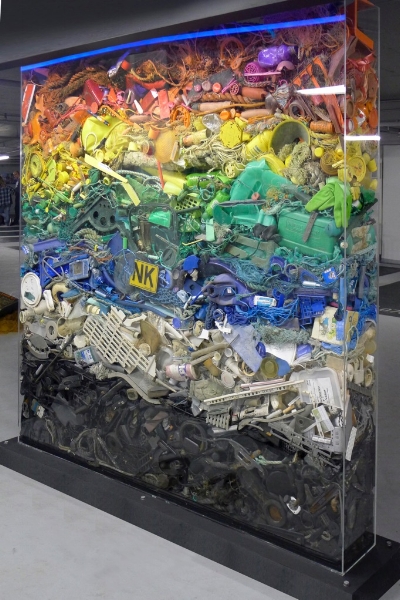Blue Dot Project: Bringing Art and Activism together for the Planet at House of Vans
Scientists reckon that 12 million tonnes of plastic are dumped into the world’s oceans every year. We can’t escape the fact that we’re responsible: we’re just too used to ‘single use’ plastics in the ‘waste culture’ of our consumerist lives. We simply don’t think about our lifestyle’s effects on marine life and the ocean. Eliza Hamer and Millie Edwards, who founded the Blue Dot Generation, want to bring the arts to the fight against marine pollution. They say that ‘artists can communicate crucial issues’ and ‘translate the urgency for change’ in ways that others can’t. Join them for an evening with activists, experts, artists and entrepreneurs for ‘Arts for Education’ at the House of Vans, London (26-30 Sep., 2018).
Maria Arceo’s Neocide (2016)
One of the ways in which ‘Arts for Education’ refocuses the viewer’s attention on the plight of the world’s oceans is through the diverse backgrounds of the featured artists. Jasmine Pradissitto’s Plastic Planet (2016) could only be made by someone of her scientific background. It’s strange to see plastic so imbued with an otherworldly sense of being; you sense that it’s not organic, yet looks like anything might under the microscope—it’s almost Trojan, which it is when consumed by birds, turtles and other such life. You feel that it wouldn’t fit in Lisa Catherwood’s Down the Eternal Stream (2017) which is ostensibly a portrait of some koi, but set against a backdrop of patterned shells, coral and tentacles. Here, there’s a playfulness at work that offers as much in the work’s periphery as the centre.
Maria Arceo’s Neocide (2014) employs a geological metaphor: discarded plastics are stacked on top of one another to mimic layers of sediment and context. (Arceo’s fascination with archaeology is at work here.) The objects that make up the ‘sediment’ are bright and playful, but the message is anything but. I like that one of the objects is a discarded game console—the price to our oceans seems a poor trade for a few hours of distraction… It’s all ‘found’ debris from rivers and shorelines near the artist’s studio. You can’t escape thinking that that actually once belonged to someone. And then, a guilty moment. You wonder how much of your own waste is floating about in the great blue deep. It’s pretty wonderful art actually.
One of the works I was drawn to was Molly Gibson’s Think Before You Drink (2017). She saturates the images in the advert style of the 1980s. In doing so, she evokes the decade that did more than any to encourage the ‘waste culture’ of today. Here, the water is given—with much spillage—to manikins who can’t, obviously, drink. Likewise, Melanie King’s Pale Blue Dot (2017) brings an astronaut/cosmonaut’s perspective to life on earth. They, she explains, ‘reported a shift in their perception, seeing the Earth and all living beings as interconnected, all living on what they call ‘Space Ship Earth’. The astronauts could see no borders from space, and deeply wished that others could see what they saw - A planet which supports all conscious life in the universe, conscious life which is endangered from war and ecological impact.’
Sangeeta Bhagawati’s In Unfamiliar Water (2017)
Sangeeta Bhagawati’s In Unfamiliar Water (2017) is still my favourite. She overlaps faint intimations of the human form over those of a gigantic fish swimming in sunset-coloured waters. She brings out the deep interconnectedness of ourselves and marine life in the oceans. You get a sense that our ancestors, millennia ago, would have understood this work, which seems extraordinarily timeless at a time when time is running out.
Here, there are offers of hope, cries of despair, and reminders of the sea’s beauty. Yet they all make us think about what we are doing to the sea and the urgent need to protect our most precious common heritage. It’s all for good cause and all the works are for sale (£100-£15,000).

